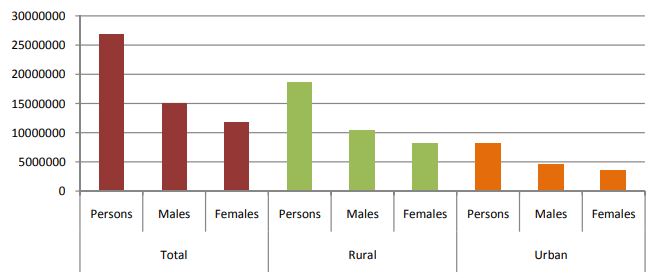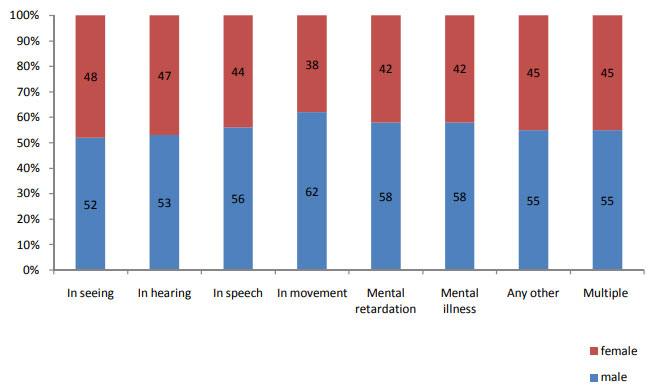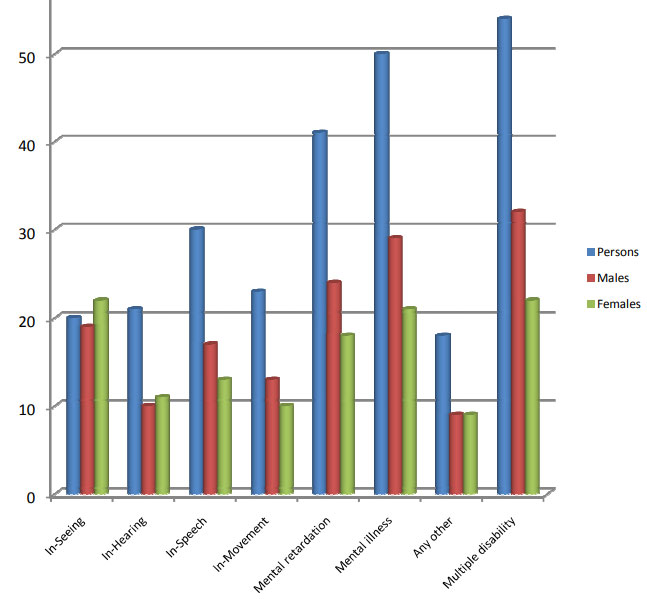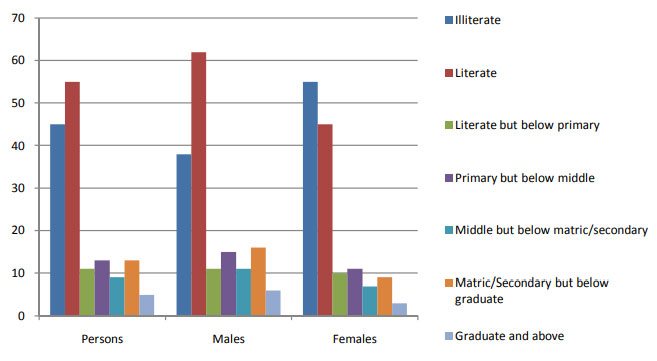We recently created and published an infographic on disability statistics in India. This infographic is based on the Census of India 2011 data. Today we are presenting the data on disabled population in India. This data is based on a report by the Social Statistics Division of the Ministry of Statistics and Programme Implementation, Government of India.
Disabled Population in India
Overall Disabled Population
Overall, 2.21% of Indian population has one or the other kind of disability. This means 2.68 crore (26.8 million) people in India are disabled.
Disabled Male Population
Out of total 62.32 crore male Indian citizens, there are 1.5 crore (15 million) disabled males in India.
Disabled Female Population
Out of total 58.76 crore female Indian citizens, there are 1.18 crore (11.8 million) disabled females in India.
Disabled Population living in Rural / Urban Areas
About 69% of the overall disabled Indian population lives rural areas. This tells us that 1.86 crore (18.6 million) disabled people live in rural areas.
Only about 0.81 crore (8.1 million) disabled people live in urban areas.

Disabled Population by Type of Disability
Following is the breakup of disabled Indian population by the type of disability. Please note that before RPWD Act 2016, only seven types of disabilities were recognized. Under RPWD Act 2016 a total of 21 types of disabilities are recognized.
- 19% people have vision related disabilities
- Another 19% people have hearing related disabilities
- 7% people have speech impairment
- 20% people have locomotor disabilities
- 6% people are affected by mental retardation
- 3% people are suffering with mental illness
- 18% people have other types of disabilities
- 8% people have multiple disabilities
In all the above cases, males are more affected than females.

| Disabled Type | Males | Females | Total |
|---|---|---|---|
| In Seeing | 2639028 | 2394403 | 5033431 |
| In Hearing | 2678584 | 2394330 | 5072914 |
| In Speech | 1122987 | 875705 | 1998692 |
| In Movement | 3370501 | 2066325 | 5436826 |
| Mental retardation | 870898 | 635066 | 1505964 |
| Mental Illness | 415758 | 307122 | 722880 |
| Multiple Disability | 1162712 | 953986 | 2116698 |
| Others | 2728125 | 2199464 | 4927589 |
Disabled Population in India by Age Group
- 5% of all disabled people are in the age group of 0-4 years
- 7% disabled people are in the age group of 5-9 years
- 17% disabled people are in the age group of 10-19 years
- 16% disabled people are in the age group of 20-29 years
- 13% disabled people are in the age group of 30-39 years
- 12% disabled people are in the age group of 40-49 years
- 9% disabled people are in the age group of 50-59 years
- 10% disabled people are in the age group of 60-69 years
- 7% disabled people are in the age group of 70-79 years
- 3% disabled people are in the age group of 80-89 years
- 1% disabled people are in the age group of 90+ years (or age not specified)
The percentage of disabled is highest in the age group 10-19 years followed by age group 20-29 years for both the male and female disabled persons.
Among the disabled males, 18% are elderly (above 60 years of age) whereas 23% of female disabled are elderly.

Education in Indian Disabled Population
In 2011, only 61% of the disabled children aged 5-19 years were attending educational institution. 12% had attended earlier and 27% never attended an educational institution.
In the age group of 5-19 years, only 43% of girls were attending school/college.
Data shows that disabled children of 5-19 years age group, more children in rural areas never attended school or left education in midway.
The following chart shows percentages of male and females who never attended educational institution by the type of disability:

As the chart shows, 54% people with multiple disabilities never attended an educational institution. Also we can see that vision-impairment and multiple disabilities almost equally affect education of females.
Literacy of Disabled Population in India
Of the total disabled population, nearly 55% or 1.46 crores (14.6 million) people are are literates.
62% of males and only 45% of females are literate.
In the rural areas, 49% of the disabled are literates while in urban areas, the percentage of literates among disabled population is 67%.
Educational Status of Indian Disabled Population
Among the male disabled persons, 38% are illiterates. 16% of the disabled male population has matric/ secondary education but are not graduates and 6% are graduates and above. About 9% among the male disabled literates are graduates.
Among the female disabled persons, 55% are illiterates. 9% of the disabled female population has matric/ secondary education but are not graduates and 3% are graduates and above. About 7.7% among the female disabled literates, are graduates.

Marriage and Disabled People in India
46.87% of the total disabled persons are currently married, whereas 41.72% are never married and 10.29% of them are widowed.
| Gender | Married | Unmarried | Widowed |
|---|---|---|---|
| Males | 8266748 | 3648631 | 706626 |
| Females | 7289492 | 2037787 | 2047553 |
Among the total disabled persons in the age group 15+ years, 59% are currently married and 13% are widowed. Among the male disabled, 62% are currently married and 6% are widowed while for female disabled, the corresponding figures are 54% and 13% respectively.
View the full report: Disabled Persons in India: A statistical profile – 2016
We hope that this data will be of help to you in your research and decision making. If you have any comments, suggestions or questions — please feel free to post in the comments section. Thank you for connecting with WeCapable!
Use the citation below to add this article to your bibliography
"Disabled Population in India: Data and Facts." Wecapable.com. Web. May 31, 2025. <https://wecapable.com/disabled-population-india-data/>
Wecapable.com, "Disabled Population in India: Data and Facts." Accessed May 31, 2025. https://wecapable.com/disabled-population-india-data/
"Disabled Population in India: Data and Facts." (n.d.). Wecapable.com. Retrieved May 31, 2025 from https://wecapable.com/disabled-population-india-data/

Its very useful information & help me a lot in my college Project works
Dear Lalit kumar,
First of all I will congratulate you for the movement you are conducting for Divyang people. I would like to suggest following points for upliftment of Divyang.
1) There should some seats reserve for the child of Divyang in Profession course like Engineering, Medical, etc in Govt & Pvt institutions also.
2) The concession U/s 80U of Income tax Act, 1961, is allowed to amount Rs.50000/- which is very short. This limit shall extend atleast up to 150000/-
3) The state Transport Ticket concession shall be granted in any state though the Divyang is of any state.
4) The UDID card shall only a single evidence for any concession for state transport, railway, air ticket and for all other facilities.
I request you to represent above points at different forum.
congratulations to lalit ji for working on disabilities. very informative data presented in effective manner
Dear Lalit jee,
I have two daughters and both are hearing impaired.
Though late they received their cochlear implant and attending normal schooling.
The elder daughter is now studying in Class IX and he younger daughter is in Class VIII.
For making them capable I must acknowledge the dedication of my wife. They way she took all these challenges positively and courageously is unbelievable.
Also I acknowledge the contributions of the Doctors, Rehabilitation Experts and above all the teachers of her school.
Now we are a happy family.
dear sir,
kindly please let me know the percentage of workers who are getting permanently Disabled and partially disabled per year trough construction sites in India.
Dear Sir,
Please publish statistics of school going children who have ASD. Also how many autistic children are enrolled in each grade in India in 2020?
Thanks in advance. I need this data for my research.
Namaste sir,
Please furnish the information about Disabled People information i.e. Total Disabled population and male & Female % and literacy %, Employement % and rural area & urban area % in Visakhapatnam.